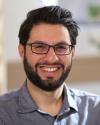--> Schedule of Readings here <--
Is there a singular practice of pilgrimage in Muslim societies? How do secular sites of pilgrimage coexist with religious ones? What makes Mecca sacred for different pilgrims? We will be exploring such questions in Roads to Mecca!
Pilgrimage is a shared practice among all cultures. Pilgrims embark on arduous and financially burdensome journeys to deepen their faith, define their place in an imagined community, pay homage to a site of religious, national or tribal memory, seek personal adventure, gain access into social networks, fulfill an obligatory task, form solidarity with a just cause, search for moral and spiritual meaning, or satisfy a longstanding curiosity.
Muslim pilgrims have produced a diverse body of literature in different languages on their experiences of pilgrimage. Roads to Mecca considers pilgrimage narratives as a literary genre and will subject it to analysis: Who is a pilgrim? Upon what terms do pilgrims articulate notions of faith and community? Our focus will be Muslim lands, a vast cultural geography shaped by various forms of religious subjectivity. We will also examine comparative cases beyond Mecca as a site of pilgrimage and Islam as a religious community. Intrigued yet?
How’s this course good for your life?
We are not just reading a particular type of literature (pilgrimage writing) and focused on a specific religious community (Islam), we are ultimately cultivating critical thinking skills that you will draw on in your professional and personal life well beyond the university. By critical thinking, I mean the ability to keep our assumptions about peoples and cultures in check, the ability to identify ethnic, religious, linguistic, and cultural difference as a product of broader social systems and not unchanging traits attributed to large groups of people, the ability to approach complex subjects such as religious practices not just with intellectual curiosity but also with a wide range of understanding and empathy. This exercise will only succeed if we engage with the cultural and historical specificity of our subject at hand. Critical thinking is a never-ending process of individual and societal growth.
What will you learn in ten weeks?
- How to read a pilgrimage narrative:
- Collectively, we will cultivate a set of questions and shared vocabulary with which to read each pilgrimage narrative in a nuanced and imaginative manner. Ultimately, this is a literature course, so we will foreground the linguistic and literary aspects of these narratives as opposed to their religious and historical aspects.
- Understand the relationship between pilgrimage and travel:
- We live in an era that equates travel with tourism, the latter reserved for people with disposable income. Tourism is seen as a more common or neutral form of travel while pilgrimage is seen as a religious practice only. But do these mutually exclusive categories explain how travel and pilgrimage interacted before the rise of the middle class and tourism as a capitalist industry? In other words, pilgrimage is not a facet of religiosity only, but a historical form of human mobility.
- Gain a nuanced understanding of Muslim lands as a cultural geography:
- Each pilgrimage narrative represents Muslim lands in a different way. By critically reading these works, we will gain a deeper understanding of this deeply pluralistic cultural geography and what it has meant at different times to different pilgrims.
- What do such terms as “sacred,” “boundary,” “border,” and “mobility” mean in different time periods?
